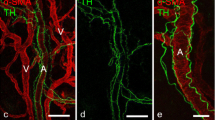Abstract
In order to study any morphological effects that vasoactive drugs might exert on cortical bone capillaries, Swiss mice received one intravenous bolus injection each of epinephrine, ATP and insulin. In one control group saline solution was injected and another was not treated. All animals were handled in the same way. A piece of the tibia diaphysis was resected and prepared for transmission electron microscopy (TEM). The lumina and the endothelia of capillaries were submitted to computerized morphometry. Some significant changes were noted: epinephrine increases both the width of the lumen and the endothelium. ATP decreases the endothelium. Insulin (hypoglycaemia?) thickens the endothelium. These finding suggest some physiological hypotheses: the epinephrine-induced widening of the lumen and the thickening of the endothelium might reflect a decreased extravasal space and oedema of cortical bone that might cause the diffusion of minerals to take longer. Intracortical perfusion pressure would then decrease and the bone perfusion rate increase. ATP might reduce the transcapillary diffusion time and increase the extravasal space in cortical bone. Apparently there are specific insulin receptors in cortical bone capillaries.
Zusammenfassung
Es sollte herausgefunden wurden, ob vasoaktive Pharmaka morphologische Veränderungen in kortikalen Knochenkapillaren machen können. Dazu erhielten Swiss-Mäuse i.v.-Bolusinjektionen von Adrenalin, ATP and Insulin. Eine Kontrollgruppe blieb unbehandelt; einer anderen wurde isotonische Kochsalzlösung injiziert. Alle Tiere wurden in gleicher Weise gehandhabt: Das mittlere Stück der Tibiadiaphyse wurde reseziert and für die TEM aufgearbeitet. Die Lumina and die Endothelien der Kapillaren wurden morphometriert. Dabei fanden sich einige signifikante Unterschiede: Adrenalin vergrößert sowohl die Lumenweite als auch die Endotheldicke. ATP verdünnt das Endothel. Insulin (die Hypoglykämie?) verdickt das Endothel. Diese Befunde begründen einige physiologische Hypothesen: Die Adrenalineffekte könnten eine Verkleinerung des Extravasalraums and ein intraossäres Ödem bedeuten, was die Diffusionszeit von Mineralien verlängerte. Der intrakortikale Perfusionsdruck nähme ab and die Perfusionsrate des Knochens stiege. ATP würde die Diffusionszeit reduzieren and den Extravasalraum vergrößern. Offenbar haben Kapillaren auch im Knochengewebe spezifische Insulinrezeptoren.
Similar content being viewed by others
Literatur
Agostini A, Cicardi M, Porreca W (1992) Peripheral edema due to increased vascular permeability: A clinical appraisal. Int J Clin Lab Res 21:241–246
Bar RS, Dolash S, Dake BL, Boes M (1986) Cultured capillary endothelial cells from bovine adipose tissue: A model for insuline binding and action in mircovascular endothelium. Metabolism 35:317–322
Brandi ML (1992) Bone endothelial cells: A tool for analyzing cell to cell interactions in the skeletal tissue. EXS 61:250–254
Brinker MR, Lippton HL, Cook SD, Hyman AL (1990) Pharmacological regulation of the circulation of bone. J Bone Joint Surg [Am] 72:964–975; 1270 (Erratum)
Buchanan RA, Wagner RC (1990) Morphometric changes in pericyte-capillary endothelial cell associations correlated with vasoactive stimulus. Microcirc Endothelium Lymphatics 6: 159–181
Cooper RR, Milgram JW, Robinson RA (1966) Morphology of the osteon. An electron microscopic study. J Bone Joint Surg [Am] 48:1239–1271
Davies DR, Bassingthwaighte JB, Kelly PJ (1976) Transcapillary exchange of strontium and sucrose in canine tibia. J Appl Physiol 40:17–22
Dean MT, Wood MB, Vanhoutte PM (1992) Antagonist drugs and bone vascular smooth muscle. J Orthop Res 10:104–111
Döhler JR, Robertson S, Hughes SPF (1986) The effect of sympathomimetic drugs on bone capillaries. Arch Orthop Trauma Surg 105:62–65
Drenckhahn D (1983) Cell motility and cytoplasmic filaments in vascular endothelium. Progr Appl Microcircul 1:53–70
Driessens M, Vanhoutte PM (1979) Vascular reactivity of the isolated tibia of the dog. Am J Physiol 236:H 904–908
Gross PM, Heistad DD, Marcus ML (1979) Neurohumoral regulation of blood flow to bones and marrow. Am J Physiol 237: H 440–448
Hammersen F, Hammersen E (1990) The ultrastructure of microvascular endothelial cell reactions to various stimuli. Orthop Rel Sci 1:3–13
Hermann IM, d'Amore PA (1985) Microvascular pericytes contain muscle and nonmuscle actins. J Cell Biol 101:43–52
Hooper G, McCarthy ID, Wootton R, Hughes SPF (1984) Fluid spaces in the canine tibia. In: Arlet J, Ficat RP, Hungerford DS (eds) Bone circulation. Williams & Wilkens. Baltimore, pp 204–206
Hughes SPF, Lemon GJ, Davies DR, Bassingthwaighte JB, Kelly PJ (1979) Extraction of minerals after experimental fractures of the tibia in dogs. J Bone Joint Surg [Am] 61:857–866
Hughes SPF, McCarthy ID, Hooper G (1986) The vascular system in bone. Its importance and relevance to clinical practice. Clin Orthop 210:31–36
McCarthy ID, Hughes SPF (1983) The role of skeletal blood flow in determining the uptake of 99 mTc-methylene-diphosponate. Calcif Tissue Int 35:508–511
McCarthy ID, Davies R, Hughes SPF (1985) The response of the microcirculation in bone to the administration of noradrenaline and ATP. J Bone Joint Surg [Br] 67:319
Sherman MS (1963) The nerves of bone. J Bone Joint Surg [Am] 45:522–528
Simonet WT, Bronk JT, Pinto MR, Williams EA, Meadows TH, Kelly PJ (1988) Cortical and cancellous bone: Age related changes in morphological features, fluid spaces, and calcium homeostasis in dogs. Mayo Clin Proc 63:154–160
Solenski NJ, Williams SK (1985) Insulin binding and vesicular ingestion in capillary endothelium. J Cell Physiol 124:87–95
Tillmann B, Töndury G (1987) Knochengewebe. In: Leonhardt H, Tillmann B, Töndury G, Zilles K (Hrsg) Anatomie des Menschen. Lehrbuch and Atlas, Bd. 1, Bewegungsapparat. Thieme, Stuttgart, S 38–49
Tothill P, Hooper G, McCarthy ID, Hughes SPF (1985) The variation with flow-rate of the extraction of bone-seeking tracers in recirculation experiments. Calcif Tissue Int 37:312–317
Tran M-A, Géral J-P (1978) The influence of some vasoactive drugs on bone circulation. Eur J Pharmacol 52:109–114
Weiss L (1988) Cell and tissue biology. A textbook of histology, 6th edn. Urban & Schwarzenberg, München Wien Baltimore
Author information
Authors and Affiliations
Additional information
In memoriam Prof. Dr. Werner Lierse, vormals Direktor des Instituts für Neuroanatomie, Universitätskrankenhaus Eppendorf, Hamburg
Rights and permissions
About this article
Cite this article
Döhler, J.R., Hennig, F.F. & Hughes, S.P.F. Zur reagibilität von kortikalen Knochenkapillaren. Langenbecks Arch Chir 380, 176–183 (1995). https://doi.org/10.1007/BF00207726
Received:
Issue Date:
DOI: https://doi.org/10.1007/BF00207726




